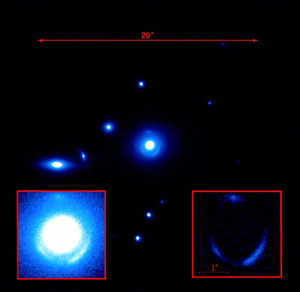A tiny galaxy nearly halfway across the universe, the smallest in size and mass known to exist at that distance, has been identified and studied by an international team of over a dozen scientists, including four at the University of California, Santa Cruz.
The galaxy is about half the size, and approximately one-tenth the "weight" of the smallest distant galaxies typically viewed with the Hubble Space Telescope, and it is 100 times smaller in mass than our own Milky Way. Astronomers were able to observe it because a massive galaxy in the foreground acts as a "gravitational lens," focusing light from the more distant galaxy.
"By using the foreground galaxy as a cosmic gravitational lensing telescope, we have multiplied by 10-fold the sharpening power of our Keck Telescope in Hawaii, giving us the equivalent of a telescope with a mirror the size of a football field," said David Koo, professor of astronomy and astrophysics at UCSC and a coauthor of the paper. "This gives us a glimpse of an ancient pygmy galaxy like those that may have built up our home galaxy, the Milky Way."
The Hubble Space Telescope and the Keck II Telescope in Hawaii were both used in this research, which will be published in the December 20 issue of the Astrophysical Journal. The article is now available online.
"Even though this galaxy is more than 6 billion light years away, the reconstructed image is as sharp as the ordinary ground-based images of the nearest structure of galaxies, the Virgo cluster, which is 100 times closer to us," said lead author Phil Marshall, a postdoctoral fellow at UC Santa Barbara.
Second author Tommaso Treu, assistant professor of physics at UCSB, explained that the image of the newly discovered galaxy appears as an "Einstein Ring" due to gravitational lensing. Light from distant galaxies is deflected on its way to Earth by the gravitational field of any massive object that lies in the way. Because the light bends, the galaxy is distorted into an arc or multiple separate images. When both galaxies are exactly lined up, the light forms a bull's-eye pattern, called an Einstein ring, around the foreground galaxy.
The combination of optical and near-infrared images from the Hubble Space Telescope and longer-wavelength images obtained from the Keck Telescope enabled astronomers to estimate the mass of the galaxy and infer that many of its stars had formed only recently.
"If the galaxy is representative of a larger population, it could be one of the building blocks of today's spiral galaxies, or perhaps a progenitor of modern dwarf galaxies," Treu said.
A key aspect of the research is the use of "laser guide star adaptive optics" at the W. M. Keck Observatory in Hawaii. Adaptive optics (AO) systems use a bright reference point in the field of view to measure the Earth's atmospheric blurring and correct for it by deforming the telescope's mirrors in real time. The Keck laser guide star AO system uses a powerful laser to illuminate a layer of sodium atoms in the Earth's upper atmosphere. The result is an "artificial star" bright enough to perform AO corrections at any position in the sky, thus enabling much sharper imaging over most of the sky.
Several members of the team are affiliated with the Center for Adaptive Optics (CfAO) at UCSC, including Claire Max, CfAO director and a professor of astronomy and astrophysics at UCSC; postdoctoral fellow Jason Melbourne; graduate student S. Mark Ammons; and David Le Mignant of the W. M. Keck Observatory. The Keck AO data were collected by Melbourne as part of the CfAO Treasury Survey (CATS).
Other researchers involved in the project are Raphael Gavazzi of UC Santa Barbara; Kevin Bundy of the University of Toronto, Canada; Adam S. Bolton of the Institute for Astronomy at the University of Hawaii; Scott Burles of the Massachusetts Institute of Technology; James Larkin of the University of California, Los Angeles; Leon V.E. Koopmans of the Kapteyn Astronomical Institute, the Netherlands; Leonidas A. Moustakas of the Jet Propulsion Laboratory and the California Institute of Technology; Eric Steinbring of the University of Victoria, Canada; and Shelly A. Wright of UC Los Angeles.
This research is supported by NASA, the National Science Foundation, and the Sloan Foundation.
Note to reporters: You may contact Koo at (831) 459-2130 or koo@ucolick.org.




